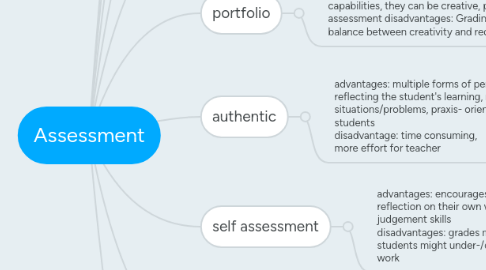
1. diagnostic
1.1. advantage: gives instructor information about student's prior knowledge
1.1.1. example: before I start teaching the conjunctive II I give the students an exam on conjunctive I to make sure all students have the necessary skills before starting a new grammar chapter
1.1.1.1. Purpose: Diagnostic assessment’s goal is to find out where students stand, to examine the previous knowledge. It is FOR learning because teachers make sure everybody has the required knowledge before starting a new topic for example.
1.1.1.1.1. Definition: Diagnostic assessment can be used to diagnose strengths and areas of need in all students. It involves the gathering and careful evaluation of detailed data using students' knowledge and skills in a given learning area.
2. formative
2.1. advantage: identifying and responding to the students’ learning needs
2.1.1. example: I read phrases in the foreign language. Thumb up, if phrase is correct, thumb down if it is wrong.
2.1.1.1. Purpose: Formative assessment monitors student learning to provide ongoing feedback. Therefore it is FOR learning.
2.1.1.1.1. Definition: Formative assessment including diagnostic testing is a range of formal and informal assessment procedures conducted by teachers during the learning process in order to modify teaching and learning activities to improve student attainment.
3. summative
3.1. advantage: highly visible forms of tracking progress disadvantage: not effective in terms of supporting student's learning
3.1.1. example: vocabulary test
3.1.1.1. Purpose: Summative assessment = OF learning
3.1.1.1.1. Purpose: summative assessment is used to evaluate student learning at the end of a unit. Therefore it is OF learning.
4. performance based
4.1. advantages: practical application of skills, students can assess their own progress, students are active participants disadvantages: subjective judjement- more difficult to grade, no clear right/wrong
4.1.1. example: students work in groups on a project, they plan a trip to city in a country where target language is spoken. They have to follow guidelines (budget/time period)
4.1.1.1. Purpose: Performance based assessment requires students to demonstrate knowledge and skills. Therefore they are OF learning.
4.1.1.1.1. Definition: Performance-based testing is an alternative to traditional testing that is designed to encompass a better overall representation of student progress including the effectiveness of teacher lesson plans, worksheets and study skills. The idea with performance-based testing is to gather a demonstration of the scope of knowledge a student has on a subject rather than simply testing the accuracy of their response on a selection of questions.
5. high stakes
5.1. advantages: transparence, fairness, disadvantages: cause anxiety, pressure for students
5.1.1. example: final high school exams, college entry exams
5.1.1.1. Purpose: High stakes tests often have important consequences for test takers, as a high school diploma; they can be standardised tests. Therefore they are OF learning.
5.1.1.1.1. Definition: A high-stakes test is any test used to make important decisions about students, educators, schools, or districts, most commonly for the purpose of accountability—i.e., the attempt by federal, state, or local government agencies.
6. portfolio
6.1. advantages: students can prove their real world professional capabilities, they can be creative, personalised form of assessment disadvantages: Grading is very time consuming, balance between creativity and requirements for portfolios
6.1.1. example: students develop a reading portfolio over the semester (can include summaries, vocabulary, pictures, letters to characters etc. )
6.1.1.1. Purpose: Portfolio assessment gives students the opportunity to demonstrate their knowledge of a topic. They can self monitor their learning. The final project is OF learning, but the teacher can evaluate the process of learning, observe growth and difficulties and therefore it can as well be FOR learning.
6.1.1.1.1. Definition: Portfolio assessment is an evaluation tool used to document student learning through a series of student-developed artifacts.
7. authentic
7.1. advantages: multiple forms of performance measurement reflecting the student's learning, real world situations/problems, praxis- orientated, more engaging for students disadvantage: time consuming, more effort for teacher
7.1.1. example: I organize a skype coversation between my class and a class in a country where the target language is spoken
7.1.1.1. Purpose: Authentic assessment aims at students to be able to use the acquired knowledge in the real world. It is therefore OF learning.
7.1.1.1.1. Definition: Authentic assessment is the measurement of "intellectual accomplishments that are worthwhile, significant, and meaningful," as contrasted to multiple choice standardized tests. Authentic assessment can be devised by the teacher, or in collaboration with the student by engaging student voice.
8. self assessment
8.1. advantages: encourages student responsibility, reflection on their own work, improves judgement skills disadvantages: grades may be unreliable, students might under-/overestimate their work
8.1.1. example: students hold a presentation on a cultural topic and assess themselves. Or after a group project they assess themselves and their peers, following certain criteria
8.1.1.1. Purpose: Self assessment: Students reflect on and monitor their progress. It is therefore mostly FOR learning, can as well be OF learning.
8.1.1.1.1. Definition: Self-assessment, is a process whereby students grade assignments or tests based on a teacher's benchmarks. The practice is employed to save teachers time and improve students' understanding of course materials as well as improve their metacognitive skills.
9. peer assessment
9.1. advantage: encourages student involvement and responsibility, improves student's judgement skills, all students have to participate in projects because their peers will grade them disadvantage: reliability of grades, friendships may influence grades
9.1.1. example: students do a group work on a cultural topic and assess each others work at the end of project
9.1.1.1. Purpose: Peer assessment: Students assess each other (and themselves), they identify strengths and weaknesses. It is mostly FOR learning, but for example when students grade their peers in group works, it can also be OF learning.
9.1.1.1.1. Definition: Peer assessment is a process whereby students grade their peers' assignments or tests based on a teacher's benchmarks. The practice is employed to save teachers time and improve students' understanding of course materials as well as improve their metacognitive skills.
